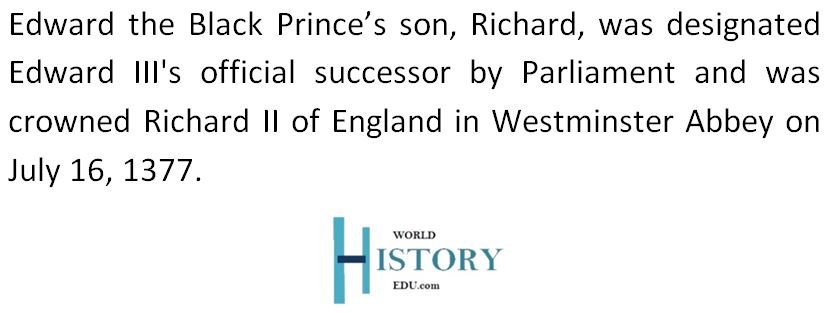Edward the Black Prince: History, Accomplishments, & Major Facts
Edward of Woodstock, known as the Black Prince, was a pivotal figure in English history, especially during the Hundred Years’ War. His military prowess and chivalric reputation made him an exemplar of medieval knighthood, embodying both the virtues and the violence of his era.
In this essay, World History Edu explores the life of the Black Prince, focusing on his background, major battles, leadership qualities, and his lasting impact on English and European history.
Early Life and Background
Born on June 15, 1330, in Woodstock Palace, Oxfordshire, Edward was the eldest son of King Edward III of England and Queen Philippa of Hainault. As the first son of a reigning king, Edward held the title of Prince of Wales, a designation for the heir apparent to the English throne.
His upbringing was marked by the martial spirit of his father, whose reign was characterized by ambitious military campaigns in France. From a young age, Edward was introduced to the arts of war and governance, receiving an education that prepared him for leadership both on the battlefield and in the court.
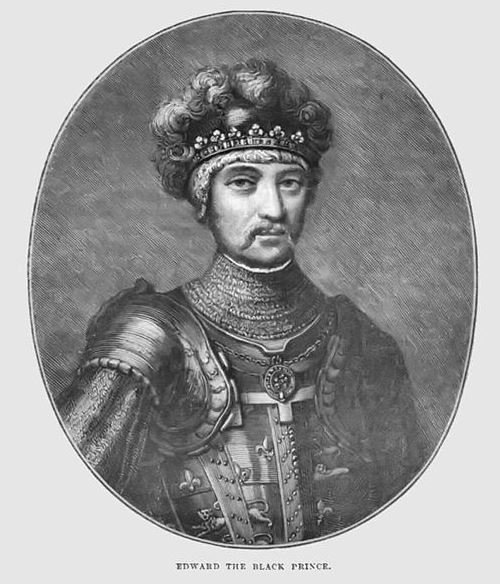
Edward the Black Prince was born on June 15 1330 in Woodstock, near Oxford. He was the eldest son of King Edward III of England and Philippa of Hainault.
The Hundred Years’ War
The Hundred Years’ War between England and France was a defining part of Edward’s life. It was a series of conflicts over claims to the French throne and territorial disputes.
Edward III claimed the French crown, citing his mother’s French lineage as the basis for his claim, which was contested by the Valois line in France. Edward the Black Prince played a crucial role in these conflicts, demonstrating exceptional military skills.
Major battles that Edward the Black Prince fought in
Edward’s military career began at the age of sixteen at the Battle of Crécy in 1346, where the English forces achieved a decisive victory against the French. His leadership and bravery were particularly noted during the battle, marking him as a significant military leader.
However, it was his role at the Battle of Poitiers in 1356 that truly distinguished him. The English army, vastly outnumbered, captured the French King, John II. This victory not only enhanced Edward’s reputation but also shifted the power dynamics in the war, leading to the Treaty of Brétigny in 1360, which temporarily eased tensions between the two nations.
Campaigns in Spain
Following the Treaty of Brétigny, the Black Prince shifted his military campaigns to Spain. His goal was to aid Pedro I of Castile, dubbed ‘the Cruel’ and ‘the Just,’ reclaim his throne from his half-brother Henry II in 1367.
The conflict in Spain provided an indirect battlefield for the ongoing English-French rivalry.
At the Battle of Najera on April 3, 1367, King Edward III led a Gascon-English army, leveraging longbow archers and mobile infantry to overpower the French-supported forces of Henry II. This victory included capturing the renowned knight Bertrand du Guesclin, whom Edward allowed to set his own ransom at a steep 100,000 Francs.
Despite the military success, the campaign drained resources and worsened Edward’s health, likely contributing to the diseases that plagued his remaining years.
Financially, the venture failed as Pedro could not compensate Edward and his army adequately, leading to discontent among Edward’s taxed subjects in Aquitaine.
From the campaign, Edward acquired the Black Prince’s Ruby, a notable but misleadingly named spinel, which later adorned the British Crown Jewels.
Governance and Later Years
Back in France, England’s situation deteriorated as Charles V of France regained territories. The capture and harsh reprisal at Limoges in 1370 damaged the English Crown’s reputation, especially after the massacre of its residents.
His health declining, Edward returned to England in 1371, leaving dwindling English possessions in France by 1375 to Calais and a narrow part of Gascony, marking a disappointing end to extensive military efforts and expenditures.
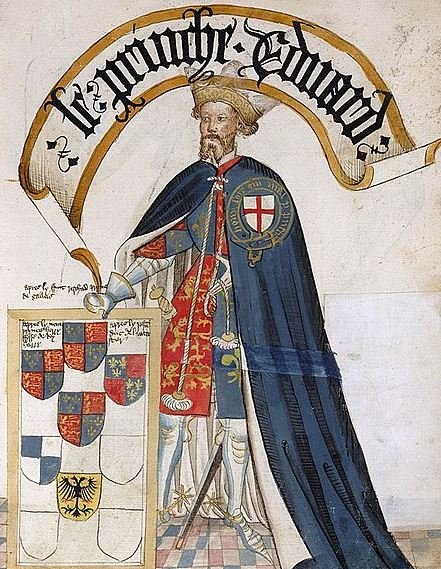
Beyond his military endeavors, Edward also held significant administrative roles. He was made the Prince of Aquitaine, a region in France granted to him by his father. Image: Edward being depicted as a Knight of the Garter in a 15th century art work.
Death and Commemoration
Edward died on June 8, 1376, at the age of 45. His death was widely mourned, and he was buried in Canterbury Cathedral with a grand tomb that remains a site of historical interest.
The effigy and heraldic symbols on his tomb reflect the high regard in which he was held and serve as a memorial to his significant role in English and French history.
Chevauchée: Edward the Black Prince’s Scorched-Earth Technique
In 1346, Edward the Black Prince was tasked with implementing a scorched-earth policy against French towns and villages, utilizing a strategy known as chevauchée.
This tactic dates back to some of the first kings of England in the 11th century. Basically, it was aimed to instill fear, supply the invading army with provisions and secure ransoms from captured nobles. Crucially, it sought to cripple the economic foundation of the enemy, thereby hindering their ability to muster an effective military response.
This strategy of economic warfare often led to widespread looting and chaos as ordinary soldiers seized the opportunity to pillage. The underlying objective was to force King Philip VI of France into open battle by escalating the conflict to a point where he felt compelled to confront the invading forces—a move that ultimately led to significant confrontations during the Hundred Years’ War.
Chivalric Image and Leadership
Edward was not only celebrated for his military achievements but also for embodying the chivalric ideals of the time. Chivalry, with its emphasis on bravery, honor, and respect for adversaries, was a central aspect of Edward’s persona.
His conduct in battles and his treatment of prisoners, such as King John II whom he captured at Poitiers, were seen as models of knightly behavior. This chivalric image helped to cultivate the loyalty of his troops and the admiration of both his contemporaries and later generations.
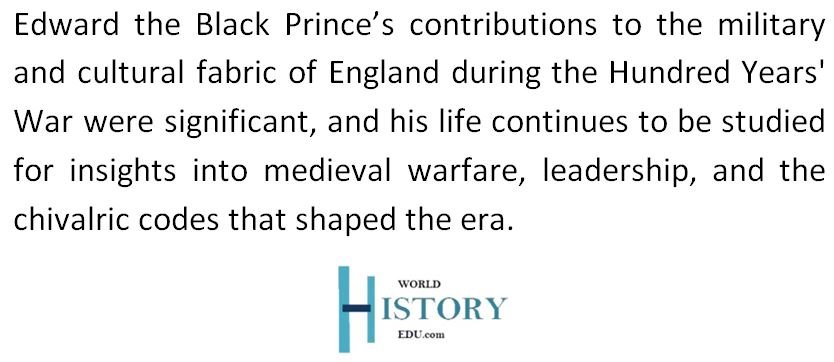
Why was he called the Black Prince?
The title “Black Prince” for Edward of Woodstock, Prince of Wales, is a posthumous nickname whose origins are somewhat uncertain. And unbeknownst to many, this name was not used during his lifetime.
However, our historians have several theories about why this nickname was attached to Edward.
One popular explanation is that Edward wore black armor in battle, which was distinctive and memorable. Black armor would have been notable for its striking appearance and could have inspired the nickname due to its association with his formidable presence on the battlefield.
Another theory suggests that the name could be related to his military prowess and the fear he instilled in his enemies.
Alternatively, it might have referred to his harsh treatment of the French territories he governed; for instance, his sack of Limoges in 1370 where many civilians were killed, could have contributed to a darker reputation.
The name might also derive from the heraldic colors or the symbols used in his shield or coat of arms, which included black elements.
Edward the Black Prince and the Order of the Garter
He was also a founding member of the Order of the Garter, established around 1348 by King Edward III. This prestigious order, still England’s most distinguished, initially included only 24 knights who had proven their valor at the Battle of Crécy, emphasizing deeds over mere nobility.
The Order’s emblem, a garter, was typically worn over armor and bore the motto “Honi soit qui mal y pense” (‘Evil be on him who thinks it’), a defiant message against doubters of the king’s claim to the French throne. Also, the emblem was symbolically reinforced by the garter’s colors of gold and blue, reflecting the royal French hues.
Did you know…?
- At just seven years old, Edward the Black Prince received his first suit of armor, heralding his future as a formidable warrior.
- In 1337, to secure financial independence for his son, King Edward III created the Duchy of Cornwall, granting its revenues to the young prince. This made Edward the Duke of Cornwall and Earl of Chester.
- Edward the Black Prince was as enthusiastic about medieval tournaments as his father, participating in the grand 15-day event at Windsor Castle in 1344.
- The earliest known references to Edward as the “Black Prince” come from the 16th century, about 150 years after his death, indicating that the nickname evolved as part of his historical legend rather than as a contemporary moniker.
- Edward the Black Prince’s tournament helmet, displayed above his tomb, features a black finish with a prominent moulded leather lion (or leopard) atop it.
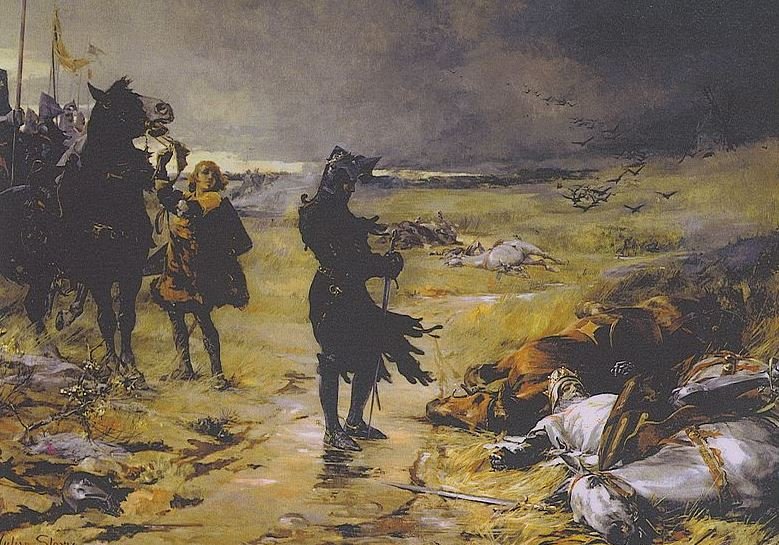
The exact reason for Edward, Prince of Wales, being called “The Black Prince” remains a bit of a mystery, blending with the romantic and brutal images of medieval chivalry and warfare. Image: A painting by titled “The Black Prince at Crécy”, showing Edward (in black) during one of his numerous battles.
Wife and Children
Edward the Black Prince married his first cousin Joan, Countess of Kent, in 1361 at Windsor Castle. Their union, marked by apparent genuine affection, was a departure from typical medieval royal marriages, which were often arranged solely for political gain.
The couple had two sons, Edward, who died in 1371, and Richard, born in 1367, who later ascended to the throne as Richard II of England, reigning from 1377 to 1399.
Known for his devout piety, the Black Prince was a generous benefactor to Canterbury Cathedral and made several pilgrimages to Walsingham and Canterbury. His reverence for the Holy Trinity is prominently featured at his tomb.
Legacy and Impact
Described as a tall and commanding figure, Edward the Black Prince’s impact on English history is profound. He was a key figure in the early stages of the Hundred Years’ War, and his victories had long-lasting effects on the geopolitical landscape of medieval Europe.
Edward’s legacy was also cultural; he was celebrated in chronicles and ballads, symbolizing the ideal medieval knight.
FAQs
When was Edward the Black Prince born?
Edward of Woodstock, known as the Black Prince, was born in 1330 and was the eldest son of Edward III of England.
How did the Hundred Years’ War begin?
The Hundred Years’ War began in 1337 when King Edward III of England claimed the French crown, challenging King Philip VI of France. This claim was based on Edward’s lineage as the nephew of the previous king, Charles IV, through his mother Isabella of France. The French rejected this claim, adhering to the Salic law that excluded inheritance through the female line.
Additionally, territorial disputes over English-controlled areas in France, like Aquitaine, fueled the conflict. These intertwined issues of succession and territorial rights sparked a prolonged period of warfare between England and France.
On the brink of major engagements, Edward III knighted his son, Prince Edward, and other young knights on July 12, 1346, signaling the escalation of their military campaign.
What is Edward the Black Prince best known for?
Named the Prince of Wales in 1343, Edward distinguished himself in the Hundred Years’ War against France, achieving major victories at Crécy in 1346 and Poitiers in 1356. At the latter, he captured the French king.
His success continued with a victory in Najera, Spain, in 1367. However, illness prevented him from making further gains.
The nickname “Black Prince” may stem from his fearsome martial reputation and his use of scorched-earth tactics against the French.
His emblem, featuring three white ostrich feathers against a black background, symbolizes the Prince of Wales, a title and symbol still used by the heir apparent to the British throne today.

Edward the Black Prince’s death in 1376, a year before his father’s, meant that he never ascended to the English throne. His son, Richard II, succeeded Edward III, leading to a continuation of the Plantagenet dynasty. Image: A painting of Richard II.
How did Edward the Black Prince lead the English to victory at the Battle of Crécy?
On 26 August 1346 CE, during the Battle of Crécy, the young Edward the Black Prince, just 16, commanded the English right wing with Sir Godfrey Harcourt.
Facing a critical moment where French forces nearly overwhelmed them, Sir Godfrey sought reinforcements.
However, King Edward III, upon hearing of his son’s predicament, famously remarked that the Prince must earn his spurs, signifying his coming of age as a knight through overcoming this challenge.
Despite their numerical inferiority (about 12,000 English to 25,000 French), Edward III’s forces secured a strong defensive position on a rise by the River Maie. The French confusion during a halted charge, coupled with the lethal efficiency of Welsh and English archers, turned the tide.
The Battle of Crécy showcased the effectiveness of Edward’s lighter, more mobile troops and the strategic use of cannons, a novelty on French soil. The English achieved a decisive victory with minimal losses compared to the catastrophic French casualties, which included numerous high-ranking nobles.
Post-battle, Prince Edward adopted the emblem and motto of the fallen King of Bohemia, symbolizing his service and chivalry. This victory at Crécy was followed by the capture of Calais in 1347 and its defense in 1350, further cementing the Black Prince’s legendary status.
What transpired at the Battle of Poitiers in 1356?
John II of France, who reigned from 1350 to 1364, inherited the ongoing war with England and repeated the battlefield mistakes of his predecessor.
In 1355-56, the Black Prince launched raids into Gascony, capturing Bordeaux and using it as a base for further incursions. His strategy of burning cities and farmlands provoked John II into confronting the English forces directly.
On September 18, 1356, a French army attempted to intercept the English before they could join forces with their compatriots in Normandy, leading to the Battle of Poitiers the following day. The terrain of vineyards, woods, and marshes played a key role in the battle.
Despite their numerical superiority – about 36,000 to 7,500 – the French were hampered by poor leadership and reliance on heavy cavalry and crossbows, making them ineffective against the English longbows.
The battle ended with around 2,100 French knights captured, including King John II. This enhanced the Black Prince’s reputation for chivalry due to his respectful treatment of his royal prisoner.
It’s been stated that Edward’s generosity extended to his own troops and allies, distributing wealth and titles and making donations to religious institutions like Canterbury Cathedral.
How did the Treaty of Brétigny come to be?
In 1359, King Edward III led a daring march on Rheims to claim the French crown, but the siege failed. This setback led to the Treaty of Brétigny in May 1360, establishing a temporary peace.
In 1362, Edward was titled Prince of Aquitaine, but the war’s dynamics changed under Charles V of France (also known as Charles the Wise), who skillfully regained territories through guerrilla tactics rather than open combat, further challenging the financially strained English crown.
When did he die?
Prince Edward, the Black Prince, died at the age of 46 on June 8, 1376, likely from dysentery, and his death was deeply mourned across the nation.
He was buried in Canterbury Cathedral, where his black helmet, shield, and gauntlets were initially displayed above his tomb.
His tomb features a gilded copper effigy depicting him in full armor, adorned with the quartered coat of arms of his father, combining the Plantagenet lions with the French fleur-de-lis—emblems of the English claim to the French throne that Edward staunchly pursued.
